Alberta |
|
|
|
| Übersicht – Contents: | |
Diese Seite ist Teil des Projektes
Flagge – Flag: |
|
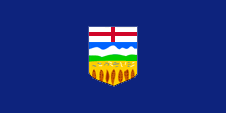 |
Provinzflagge – flag of the province, Seitenverhältnis – ratio = 1:2, Quelle/Source: Corel Draw 4   |
historische Flagge – historical Flag: |
|
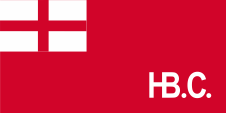 |
1682–1707, |
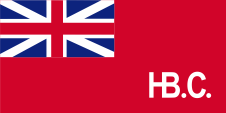 |
1707–1801, |
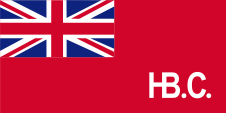 |
1801–1896, |
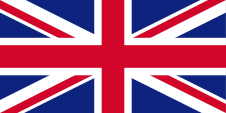 |
1896–1965, Union Flag → quasi Nationalflagge/national flag, Flagge von Großbritannien – flag of United Kingdom, Seitenverhältnis – ratio 1:2, Quelle/Source, nach/by: Wikipedia (EN), thecanadianencyclopedia.ca    |
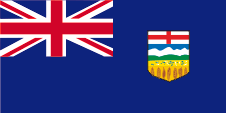 |
1907–1968, Flagge der Regierung (Staatsflagge) – flag of the government (state flag), Seitenverhältnis – ratio = 1:2, Quelle/Source, nach/by: World Statesmen |
Bedeutung/Ursprung der Flagge – Meaning/Origin of the Flag: |
|
| Die Flagge von Alberta wurde am 01.06.1968 angenommen. Sie zeigt durch das Seitenverhältnis von 2:1 und durch das dunkelblaue Flaggentuch deutlich britische Einflüsse in der Gestaltung. In der Mitte der Flagge das Wappenschild von Alberta. | The flag
of Alberta was adopet on 1st of June in 1968. It shows by the side's ratio of 2:1 and by the dark blue bunting conspicuously British influences in the designing. In the middle of the flag is placed the blazon of Alberta. |
| Bis 1922 hätte von den Dienststellen der Provinzen offiziell der britische Union Jack, die sogenannte Royal Union Flag, verwendet werden müssen, oder aber (ab 1922 im Prinzip nur noch) die kanadische blaue Dienstflagge, der typische Britische Blue Ensign, mit dem Wappenschild Kanadas im wehenden Ende. Dennoch hatten die Provinzbehörden eigene Siegel und später auch Wappen, die eigenmächtig im wehenden Ende auf der blauen Dienstflagge platziert wurden. Für dieses Verfahren hätte eine Genehmigung der britischen Behörden vorliegen müssen, was jedoch nicht der Fall war, aber toleriert wurde. Privatpersonen hatten den Union Jack zu verwenden und ab 1892 den sog. Red Ensign, die rote Version der kanadischen Flagge mit dem Union Jack in der Oberecke und dem Wappen Kanadas im wehenden Ende. | Until the
year 1922 there had officially been used, the British Union Jack, the so-called
Royal Union Flag, by the departments of the provinces, or (from 1922 nearly only) the Canadian
blue official flag, the typical British Blue Ensign, with the coat of arms of
Canada in the flying end. Nevertheless, the provincial authorities had their own seals and later also coats of arms, which were unauthorized placed in the flying end of the blue official flag. A permit should have been approved by the British authorities for this procedure, this was not the case, but was tolerated. Private individuals had to use the Union Jack and from 1892 the so-called Red Ensign, the red version of the Canadian flag with the Union Jack in the upper corner and the coat of arms of Canada in the flying end. |
| Im Zuge der allmählichen Trennung Kanadas von Großbritannien verlor der Blue Ensign als amtliches, britisches Kennzeichen seine Bedeutung und man ersetzte ihn durch neue Provinzflaggen, die von Behörden und Dienststellen der Provinzen und auch von Privatpersonen verwendet werden dürfen. So führte Alberta 1968 die heutige Flagge ein. Die Flagge der Provinz folgt aus der Historie heraus britischen Vorgaben. Es gelten: Blau = Pantone 280, Rot = Pantone 186, Gelb = Pantone 116. | In
the course of the gradual separation of Canada from the United
Kingdom the Blue Ensign as an official British flag lost its
meaning and became replaced by new provincial flags, which may
be used by authorities and departments of the provinces and also
by private individuals. In this way, Alberta introduced the
current flag in 1968. The flag of the province follows British specifications due to history. They are: Blue = Pantone 280, Red = Pantone 186, Yellow = Pantone 116. |
| Quelle/Source: Volker Preuß, Flaggen Enzyklopädie, World Statesmen | |
Wappen – Coat of Arms: |
|
 |
Wappenschild von Alberta – escutcheon of Alberta, Quelle/Source: Corel Draw 4 |
Bedeutung/Ursprung des Wappens – Meaning/Origin of the Coat of Arms: |
|
| Es gibt ein reguläres Wappen für Alberta, mit Postament, Schildhaltern, einer Wappenkrone und dem Motto. Hier dargestellt ist nur der zentrale Teil des Wappens, der Wappenschild. | There is a regular coat of arms for Alberta, with a console, shield holders (supporters), withe a crest and the motto. Here is only depicted the central part of the coat of arms, the escutcheon. |
| Das Wappenschild von Alberta zeigt im oberen Teil das englische Georgskreuz, darunter eine landschaftliche Darstellung mit Ähren im Vordergrund, dahinter Felder und am Horizont die Rocky Mountains. | The escutcheon of Alberta shows in the upper part the English Cross of St. George, beneath a scenic depiction with grain ears in the foreground, behind are fields and on the horizon the Rocky Mountains. |
| Quelle/Source: Volker Preuß | |
Landkarte – Map: |
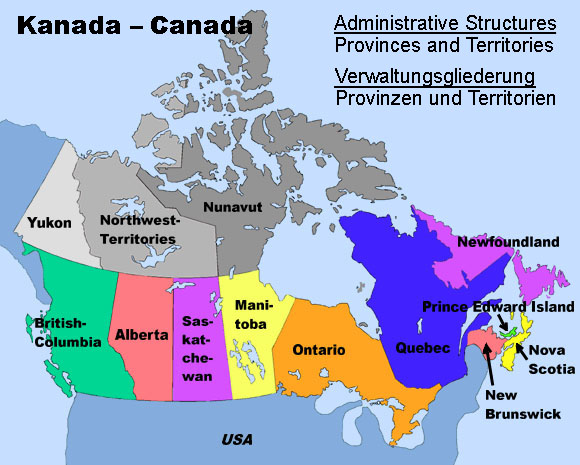 Landkarte/Map: Volker Preuß |
Zahlen und Fakten – Numbers and Facts: |
|
|
|
|
|
|
|
|
|
|
|
|
|
|
|
|
|
Geschichte: |
| 1670 · Karl II., König von
England, übergibt große Teile des heutigen
Alberta an die Hudson's Bay Company, in den folgenden Jahren Pelzhandel
mit den Ureinwohnern 1795 · Gründung von Fort Edmonton 1846 · Grenzvertrag mit Oregon, Festlegung der südlichen Grenze auf den 49. Breitengrad 1869 · die Hudson's Bay Company tritt alle ihre Hoheitsrechte an das britische Dominion Kanada ab 1882 · Gründung des Territoriums Alberta, benannt nach Louise Caroline Alberta der vierten Tochter von Königin Victoria 1890 · Entdeckung bedeutender Goldvorkommen in der Nähe von Edmonton 1905 · Gründung der Provinz Alberta, Gebietsvergrößerung im Norden durch Anschluss großer Teile des aufgelösten Athabaska-Territoriums, Edmonton wird Hauptstadt |
History: |
| 1670 · Charles II., King of
England, gives large parts of the today's
Alberta to the Hudson's Bay Company, in the following years pelt trade
with the natives 1795 · foundation of Fort Edmonton 1846 · frontier contract with Oregon, fixing of the southern border on the 49th degree of latitude 1869 · the Hudson's Bay Company cedes all their prerogatives to the British Dominion of Canada 1882 · foundation of the Territory of Alberta, named after Louise Caroline Alberta the fourth daughter of queen Victoria 1890 · discovery of eminent gold findings near Edmonton 1905 · foundation of the Province of Alberta, territorial enlargement in the north by annexion of great parts of the dissolved Territory of Athabaska, Edmonton becomes capital |
| Quelle/Source: Atlas zur Geschichte, World Statesmen, Wikipedia (D), Discovery '97 |
| Die Provinz wurde benannt nach Prinzessin Louise Caroline Alberta (1848–1939), Herzogin of Argyll, ein Mitglied der britischen Königsfamilie. Sie war das sechste Kind von Königin Victoria und Prinz Albert von Sachsen-Coburg und Gotha. | The province
was named after Princess Louise Caroline Alberta (1848–1939), Duchess of Argyll, a member of the
British Royal Family. She was the sixth child of Queen Victoria and Prince Albert of
Saxony-Coburg and Gotha. |
| Quelle/Source: Wikipedia (D) | |